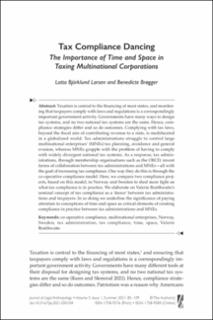Tax compliance dancing. The Importance of Time and Space in Taxing Multinational Corporations
Journal article, Peer reviewed
Published version
Permanent lenke
https://hdl.handle.net/11250/2830479Utgivelsesdato
2021Metadata
Vis full innførselSamlinger
- Scientific articles [2181]
Sammendrag
Taxation is central to the financing of most states, and monitor-ing that taxpayers comply with laws and regulations is a correspondingly important government activity. Governments have many ways to design tax systems, and no two national tax systems are the same. Hence, com-pliance strategies differ and so do outcomes. Complying with tax laws, beyond the fiscal aim of contributing revenue to a state, is multifaceted in a globalized world. Tax administrations struggle to control large multinational enterprises’ (MNEs) tax planning, avoidance and general evasion, whereas MNEs grapple with the problem of having to comply with widely divergent national tax systems. As a response, tax admin-istrations, through membership organisations such as the OECD, invent forms of collaboration between tax administrations and MNEs—all with the goal of increasing tax compliance. One way they do this is through the co-operative compliance model. Here, we compare two compliance proj-ects, based on this model, in Norway and Sweden to shed more light on what tax compliance is in practice. We elaborate on Valerie Braithwaite’s seminal concept of tax compliance as a ‘dance’ between tax administra-tions and taxpayers. In so doing we underline the significance of paying attention to conceptions of time and space as critical elements of creating compliance in practice between tax administrations and MNEs.

